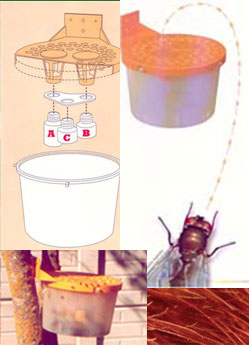Luci Trap
Blowfly attacks cost the country approximately R 40 million a year. An ewe that has been attacked by blowflies will not mate easily and will produce less wool of a lower quality. She will also have to receive high cost individual treatment.
Lucilia cuprina Blowfly
- The Lucilia cuprina is the most important attacking blowfly in South Africa.
- The primary target they attack are live wool sheep that serve as a good source of protein for their larva.
- Blowfly eggs hatch within 8 hours after its been laid.
- The larva immediately starts feeding on the skin's surface and leaves behind a distinct smell which inturn attracts secondary blowflies.
- The secondary flies causes the most damage, eating into the sheep.
- After approximately 3 to 4 days the larva develops into a cocoon,there after it falls off the sheep.
- Under ideal humid circumstances at a temperature of about 10 C, an adult blowfly can hatch 6 days after the cocoon fell off the sheep.
- Days later the females will start laying eggs.
- Lucilia cuprina lay about 1000 to 3000 eggs in their lifetime of about 21 days.
Blowfly control with Lucitrap
- The Lucitrap product was developed by the Australian Department of primary industry and the Queensland University.
- Elsenburg evaluated the traps under local conditions in South Africa. Investigations showed that the blowfly population could be successfully suppressed by the system.
- The goal with the traps are to suppress the seasonal population explosion and to limit the use of harmful chemicals.
- The trap is designed to attract and catch specifically the primary strike blowfly. Under local conditions 96% of the blowflies caught are Lucilia cuprina's, the primary blowfly.
Important:
The product is 100% environmentally friendly and there is no way that the parasite can build up an immunity against it. The blowflies are lured inside the trap through holes in the lid and dies of dehydration within hours. The product was developed to limit chemical pollution and to enhance the marketability of wool. It is an essential instrument and meets the European market requirements.
Recommendations
Bait must be replaced twice annually. when this happens the trap also has to be washed and sterilized.The blow fly enters a clean, clear trap with the most ease.
Practical information and the placement of traps (Western Cape Evaluation)
- A blowfly does not fly more than 4 km in its lifetime. The distance it can smell has not been determined.
- The traps are fixed at a height of approximately 1.2 metres against hedge poles as the blowfly flies at approximately this height.
- Blowflies lives off pollen and water and therefor prefers lowlying areas and valleys. Areas where there are worked with sheep are popular.
- Blowflies dont like to fly in the wind and this might explain why there are less blowflies found in higher areas.
- The Australians recommend that one trap be placed for every 100 ewes. Under Western Cape conditions, we are having success placing them 1.5 km apart which sustains an approximate ratio of 1:100.
- That is only a guideline. Traps should be monitored and moved if it is not attracting blowflies.
- Traps must be placed away from roads and entrance roads as it might be used as rock throwing targets.
The lifespan of the traps and bait (Lucilure)
- The lifespan of the traps are approximately 3 years. Traps that have been used during the evaluation in the Western Cape over the last four years are however still in a good condition. The effectiveness of the traps do however decrease as they get older and their colours fade.
- The bait is available in two sizes: 50ml and 80ml. The bait is fixed into the lid of the trap to activate it.
- The bait has an unlimited shelflife. The activated baitlife is approximately 5 months.
Directions for use under Western Cape conditions
- Blowfly activity is low during the winter months but it is still wise to suppress numbers.
- Blowflies hatch in large numbers in the spring after the first few warm days.
- Severe outbreaks are usually experienced during October/November.
- The activity decreases in the dry summer months while outbreaks are again expected during March/April in the Southern Cape.
- It is therefore advised to activate the traps in August/September and again in Januarie/February.
Distribution
The Lucitrap system is owned by Bioinsectaries SA (BISA) and is marketed with NWGA as important beneficiary.
|


